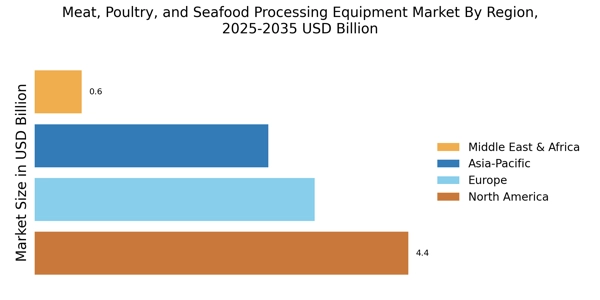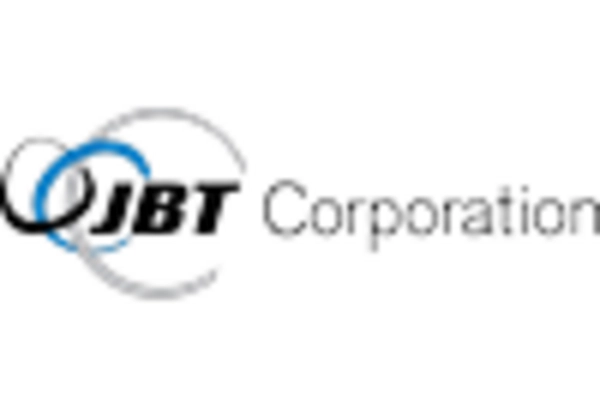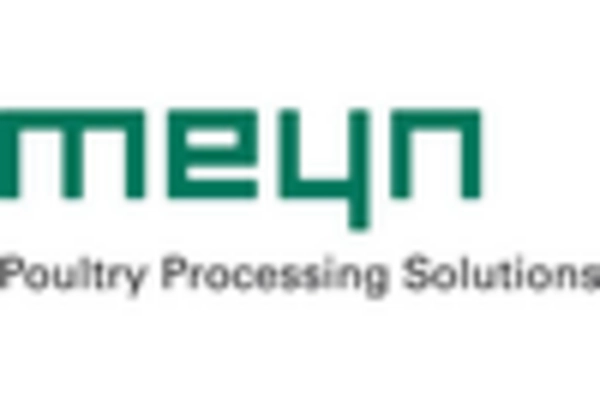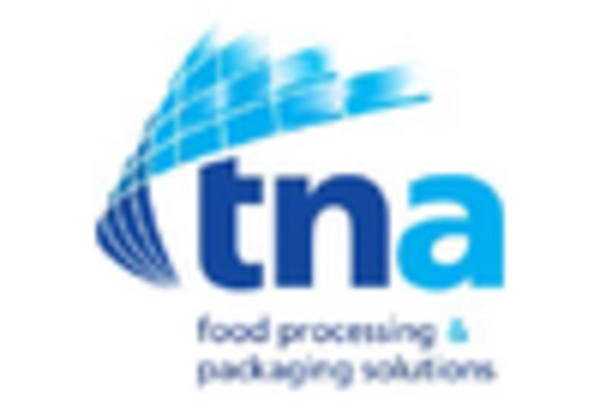Global Population Growth and Urbanization
The rapid growth of the global population and urbanization trends are significantly impacting the Meat, Poultry, and Seafood Processing Equipment Market. As urban areas expand, the demand for meat and seafood products is increasing, driven by higher disposable incomes and changing dietary preferences. This demographic shift is leading to a greater need for efficient processing equipment to meet the rising consumption levels. Projections suggest that the global meat consumption could increase by 15% over the next decade, necessitating advancements in processing technologies. Consequently, manufacturers are compelled to innovate and upgrade their equipment to cater to this burgeoning demand, thereby fostering growth in the processing equipment market.
Rising Demand for Processed Meat Products
The increasing consumer preference for convenience foods is driving the demand for processed meat products. As lifestyles become busier, consumers are seeking ready-to-eat and easy-to-prepare meal options. This trend is particularly evident in the Meat, Poultry, and Seafood Processing Equipment Market, where the production of processed meats such as sausages, deli meats, and pre-packaged seafood is on the rise. According to industry reports, the processed meat segment is expected to witness a compound annual growth rate of approximately 4.5% over the next few years. This surge in demand necessitates advanced processing equipment to ensure efficiency and quality, thereby propelling the growth of the equipment market.
Sustainability and Environmental Concerns
Sustainability is becoming a critical driver in the Meat, Poultry, and Seafood Processing Equipment Market. With growing awareness of environmental issues, consumers and businesses alike are prioritizing sustainable practices. This includes the adoption of energy-efficient equipment and waste reduction technologies. Manufacturers are increasingly focusing on equipment that minimizes energy consumption and reduces carbon footprints. Reports indicate that the market for sustainable processing equipment is likely to expand, with a projected growth rate of around 7% annually. This shift not only addresses environmental concerns but also aligns with consumer preferences for ethically produced food, thereby influencing purchasing decisions and driving demand for innovative processing solutions.
Focus on Food Safety and Quality Standards
The Meat, Poultry, and Seafood Processing Equipment Market is increasingly influenced by stringent food safety regulations and quality standards. Governments and regulatory bodies are enforcing rigorous guidelines to ensure the safety of meat and seafood products. This has led to a heightened focus on equipment that can meet these standards, such as systems that incorporate advanced hygiene features and traceability technologies. The market is witnessing a shift towards equipment that not only enhances processing efficiency but also complies with safety regulations. As a result, manufacturers are investing in high-quality processing equipment that adheres to international safety standards, which is expected to drive market growth by approximately 5% over the next few years.
Technological Innovations in Processing Equipment
Technological advancements are playing a pivotal role in shaping the Meat, Poultry, and Seafood Processing Equipment Market. Innovations such as automation, artificial intelligence, and IoT integration are enhancing operational efficiency and product quality. For instance, automated cutting and packaging systems are reducing labor costs and minimizing human error. Furthermore, the implementation of smart sensors allows for real-time monitoring of processing conditions, ensuring food safety and compliance with regulations. The market for smart processing equipment is projected to grow significantly, with estimates suggesting a potential increase of 6% annually. These technological innovations not only improve productivity but also cater to the evolving demands of consumers for higher quality and safer food products.


















Leave a Comment